


The TRACE images may be used without restrictions
in publications of any kind. We
appreciate an acknowledgement indicating that
the Transition Region and Coronal Explorer, TRACE,
is a mission of the Stanford-Lockheed Institute for Space
Research, and part of the NASA Small Explorer program. More information on
TRACE and other TRACE images can be found
here.

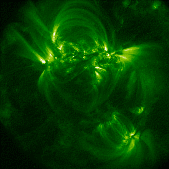 |
TRACE observed the rotation of Active Region 9373 from limb to limb
over a two week period. This this (QuickTime; JPEG/A compressed; 10.7MB)
9-day movie shows
much of that disk passage, at half the resolution (the field of view
in these 171 Å images is 350,000 km square). The movie shows,
on average, on frame every 30 minutes. Whereas the large-scale
evolution of the corona is slow enough that much of the geometry of the
field is recognizable when stepping from frame to frame, a much higher
cadence would be needed to follow the details. When playing the movie
at full speed, the corona reveals its true nature: ever-changing and full
of surprises.
 |
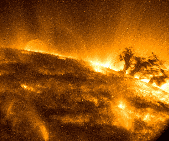 |
TRACE observed a this filament/prominence coming over the solar limb
on 27 November 1999, in its 171Å passband (1 million degrees), as
shown in this (QuickTime; JPEG/A compressed; 2.1MB)
1-day movie. The cool material in
the filament sloshes back and forth, absorbing the emission from the
hot gas behind it. We don't know what causes these motions, or even
whether they are true tornadoes, or rather just sliding back and forth
as the magnetic field that supports the cool material changes its
configuration. For another example, look at
this.
 |
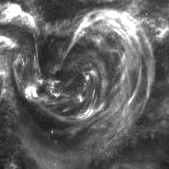 |
TRACE observed a filament activation on 10 February 2000, in
its 171Å passband (1 million degrees), shown in this
(QuickTime; JPEG/A compressed; 0.9MB)
1/2-hr movie. Part of the filament rises,
and much of the material warms up (becoming bright). The the material
is seen to spiral into the sunspot in the middle as it falls back
towards the solar surface. The field of view of the movie is
109,000 km to a side.
 |
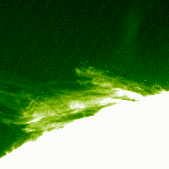 |
We have shown coronal rain here before: cool material of some 10,000 to
20,000 degrees raining out of the other hot (1-5 million degree) corona.
This particular example, observed over Active Region 9454 on 22 May 2001
from 7 to 10 UT (see this
[QuickTime; JPEG/A compressed; 3.4MB]
3-hr movie)
shows this phenomenon again. Notice how a ``shower'' blowing in
from the left (from the
north; the image was rotated over 90 degrees) moves in front of the
other loops. Its rain then appears dark against the brighter background: the
light from the loops in the background is absorbed in the foreground
loops, which are themselves less brightly emitting in this hydrogen line
(1216Å), causing the rain in front to appear as relatively dark
streaks.
 |
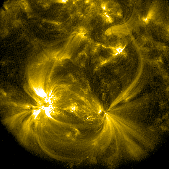 |
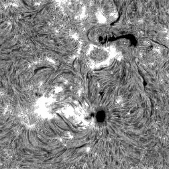
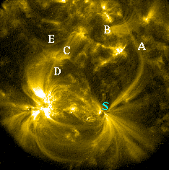
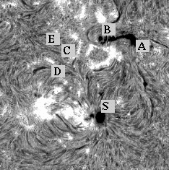 The image on the left was taken by TRACE on 24 May 2001, around 09:26 UT, in the 171Å (1 million degree) pass band. It shows Active Region 9463 in the south, and the older AR9462 in the north. It is a good example to show the remarkable complexity of the coronal magnetic field. Use the third image from the left as a map: A coronal loop near "A" connects the leading sunspot in AR9463 to a patch of magnetic field in AR9462. This loop passes over a bundle of loops starting near "B". Between the letter "B" and loop "A" you can see cool material crossing the loop bundle. In a movie, many such loops, with moving, cool material are seen to arch over the loop bundle starting at "B". In the corresponding Halpha image from Big Bear Solar Observatory, showing chromospheric material with temperatures around 10,000 degrees, you can see traces of even lower loops that cross over a filament that just shows up in the TRACE image. Then note a very thin loop near "A" in the TRACE image that is almost at right angles to the loop connecting the active regions. In the trailing part of AR9463 there is something similarly complicated: near "C" the loops show an odd kink (is there a magnetic null point nearby?), with a faint loop passing just above "D" at nearly right angles to it. Is the latter going above or below the loops connecting "C" to the trailing polarity in AR9463. And how does the loop you see near "E" fit into this picture? The coronal magnetic field is clearly very complicated,
and loops cross over and under one another in ways that are often not
expected at all. Oh, and on top of that, the loop fan coming out of
the leading sunspot at "S" is rotating, as other photospheric spots collide
with it.
|
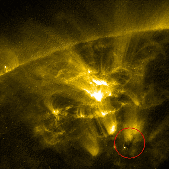 |
TRACE observed a small eruption of cool material in
Active Region 9454 on 21 May 2001, in
its 171Å passband (1 million degrees). The event occurs near
the center of the circle in this image (taken at 04:27:08 UT). Its
evolution is shown in this (QuickTime; JPEG compressed; 0.7MB)
45-min. movie (03:56-04:41).
The small eruption may be caused by a small magnetic region emerging
into the existing configuration; it throws cool material (which absorbs
the EUV emission from behind it) up to a height of approximately 40,000
km. There it disappears, either because it becomes too tenuous to see,
or because it heats up. The motion of the material is puzzling:
are we seeing field lines shake back and forth under the
stress of the extra material? Or is the bundle of
field lines rotating as it relaxes? Or is all this sideways motion but
a reflection of the timing close to the surface that determines where
material gets to be thrown up? This is another example of a
phenomenon seen by TRACE that has never been seen before; more study
is needed to understand what is really happening.
The field of view of the movie is
44,000 by 71,000 km (zoomed in by a factor of two compared to the usual
display).
 |
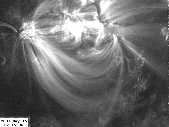
|
TRACE observed an M1 flare in Active
Region 9455 on 15 May 2001, around 2 UT, in the 171Å (1 million
degrees) pass band. This (Quicktime/JPEG; 6.7MB)
movie shows
the flare in the upper part of the field of view (640x480 pixels of
375 km each). The images are very ``soft'' and shows the flare overexposed,
because there are at least two other very interesting things happening.
First, there is another oscillating loop associated with this
flare in the middle of the field of view, as well as in loops pointing
towards the lower right (southwest). The sample of such events
has tripled in the first few months of this year.. Second, prior to the
flare, there is a very peculiar event in the lower right corner: fields
appear to unwind, and lift cool, dark material while twisting into the
higher field.
 |
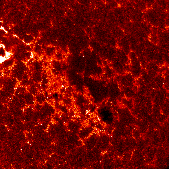 |
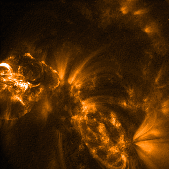
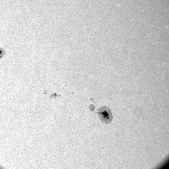 These 3 images were taken on May 3, 2001 at approximately 08:46 UT. The
field of view contains Active Regions 8447 and 8441. The (gold) 171Å
image shows a small C-class flare in progress
in the million-degree corona. The
(gray) white-light image shows the
solar surface at a temperature of about 5700 Kelvin. The dark areas
which appear in both the white-light image and the (red)
1600Å image are sunspots, where the magnetic field is very
strong, and the temperature relatively low (approximately
4000 Kelvin). Courtesy: Dawn Myers
|
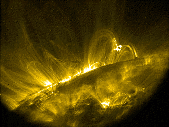 |
This image was taken by TRACE on 5 April 2001, around 6:22 UT, in the
171Å passband (1 million degrees). It demonstrates very clearly
that when you look off the solar disk, the loops stand our very clearly
against the dark sky, but there are often so many of them that the
result is confusion. Or maybe it is simply beautiful to behold.
 |
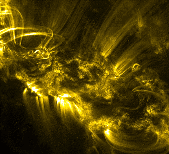 |
At about 11:26 UT, a large (M7.8) flare started in Active Region
9433, with an unusual
x-ray
intensity profile, showing a sharp, intense spike on top of a more
gradual change characteristic of long-duration events. The TRACE image
(171Å, showing emission from gas around 1 million Kelvin) was
taken at 18:37 UT, well into the decay phase of the flare. It shows
the central part of the region, with a cooling arcade on the left (west).
Notice the curtain of high loops emanating from the northern edge
of the region, going up with no indication where they come down (although
it may be in the ridge of brightenings on the southern side of the
region). The reticulated intensity pattern in the center (the moss)
lies below the hotter (3-5 MK) loops that are seen by YOHKOH.
Have a look at
YOHKOH/SXT data (unfortunately,
SXT missed the main part of the flare, showing
only the pre-flare and decay phases).
 |
|
| Home | Mission | Instrument | Team | Operations | Results | Images | Movies | Education | Site Info. | |